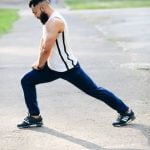Pole fitness has gained significant popularity in recent years as a unique and challenging form of exercise that combines dance, acrobatics, and strength training. Many people are intrigued by the idea of using a pole for fitness purposes, wondering, “Is pole fitness a good workout?” The answer is a resounding yes. Pole fitness offers a full-body workout that not only improves physical strength and flexibility but also enhances mental well-being.
Aside from the physical benefits like increased strength, flexibility, and improved cardiovascular health, pole fitness also provides mental benefits. Engaging in pole fitness can boost confidence levels, promote body positivity, and contribute to overall mental well-being. The combination of physical exertion and artistic expression makes pole fitness a holistic approach to wellness.
If you’re considering trying out pole fitness as part of your workout routine, it’s essential to understand the muscle groups targeted during these workouts. From the core muscles to the arms, legs, and back, pole fitness engages various muscle groups with each movement.
This comprehensive workout helps tone muscles while improving overall body coordination and control. Before diving into this exciting form of exercise, it’s crucial to learn about safety precautions to prevent injuries and maximize your workout experience.
Benefits of Pole Fitness
Pole fitness is not just a dance form but also an intense full-body workout that can offer numerous physical benefits. One of the key aspects that make pole fitness a good workout is its ability to enhance strength. The various spins, poses, and lifts performed on the pole require significant upper body and core strength to execute properly. This helps in toning muscles and building overall body strength over time.
In addition to strength, pole fitness also contributes to improved flexibility. Many of the movements in pole dancing involve stretches and extensions that help increase flexibility in different muscle groups. Regular practice can lead to better range of motion, reduced risk of injuries, and enhanced athletic performance in other activities outside of pole fitness.
Cardiovascular health is another area where pole fitness shines as a workout option. The dynamic nature of the routines, which involve continuous movement and transitions, can elevate the heart rate and provide a good cardiovascular workout. This aspect not only aids in burning calories but also improves heart health and endurance over time.
| Physical Benefit | Description |
|---|---|
| Strength | Pole fitness requires significant upper body and core strength for executing spins, poses, and lifts properly. |
| Flexibility | Movements in pole dancing involve stretches and extensions that improve flexibility in various muscle groups. |
| Cardiovascular Health | The dynamic nature of pole fitness routines elevates the heart rate, providing a good cardio workout for improved heart health. |
Mental Benefits
Pole fitness is not just a physical workout; it also has significant mental benefits that can improve one’s overall well-being. One of the primary mental benefits of pole fitness is its ability to boost confidence. As individuals master new moves and routines, they grow more confident in their abilities, both physically and mentally. This increased confidence can often translate into other areas of life, leading to a more positive self-image.
Another important mental benefit of pole fitness is its impact on body positivity. Many participants find that as they engage in regular pole fitness workouts, they become more accepting and appreciative of their bodies. The focus shifts from how the body looks to what it can do, promoting a healthier relationship with one’s physical appearance. This shift towards body positivity can lead to improved self-esteem and mental health.
Furthermore, engaging in pole fitness can have a positive impact on mental well-being by serving as a form of stress relief and emotional release. The physical activity involved in pole fitness helps release endorphins, which are known as “feel-good” hormones that can reduce feelings of stress and anxiety. Additionally, focusing on the present moment while practicing complex moves on the pole can serve as a form of mindfulness, helping individuals achieve mental clarity and relaxation.
| Physical Benefits | Mental Benefits |
|---|---|
| Strength | Confidence |
| Flexibility | Body Positivity |
| Cardiovascular Health | Mental Well-Being |
Muscle Groups Targeted
Pole fitness is a dynamic and challenging form of exercise that engages multiple muscle groups throughout the body. While many people may associate pole dancing with solely being an activity for entertainment or performance, it is important to recognize the physical benefits it offers as a workout routine. When engaging in pole fitness, various muscle groups are targeted and strengthened, contributing to overall fitness and strength development.
Upper Body
One of the primary areas of focus during pole fitness workouts is the upper body. This includes muscles in the arms, shoulders, chest, and back. Gripping the pole requires significant arm strength, while executing spins and transitions engage the shoulders and back muscles. Through repetitive movements like pulls-ups, holds, and inversions, participants can build endurance and definition in their upper body muscles.
Core
The core plays a crucial role in stabilizing the body during pole fitness routines. Moves like leg lifts, tucks, and holds require strong abdominal muscles to support balance and control. By incorporating core-strengthening exercises into their routine, individuals can develop a stronger midsection and improve overall posture.
Lower Body
Pole fitness also targets muscles in the lower body, including the quadriceps, hamstrings, glutes, and calves. As participants climb and invert on the pole, they engage these muscles to push off from the ground or hold positions. Strengthening these lower body muscles not only improves overall strength but also enhances agility and flexibility. Incorporating exercises that target these muscle groups can lead to increased power and stability in movements performed during pole fitness workouts.
Overall, by targeting a wide range of muscle groups during each session, pole fitness proves to be an effective full-body workout that can lead to improved strength, endurance, and flexibility over time.
Calories Burned
When it comes to fitness routines, many people are interested in activities that not only provide physical benefits but also help burn calories effectively. This is where pole fitness shines as a workout option that can offer a combination of strength training, cardio exercise, and flexibility work all in one. But the burning question remains: Is pole fitness a good workout for burning calories?
Calories Burned During Pole Fitness
Pole fitness is indeed a calorie-burning powerhouse. A one-hour session of pole fitness can help individuals burn anywhere from 250 to 400 calories, depending on the intensity of the workout and the individual’s body weight. The dynamic nature of pole fitness routines, which involve climbing, spinning, and transitioning between different moves, keeps the heart rate elevated throughout the session, contributing to calorie expenditure.
Pole Fitness vs. Other Workouts
In comparison to traditional workouts like running or weightlifting, pole fitness can be equally if not more effective at burning calories. What sets pole fitness apart is its engaging and full-body nature, which challenges multiple muscle groups simultaneously while incorporating elements of dance and acrobatics. This holistic approach to exercise not only enhances calorie burn during the workout but also leads to an increase in metabolism over time due to muscle development and improved cardiovascular health.
As with any exercise regimen aimed at burning calories, consistency is key with pole fitness. Regular practice not only improves strength and coordination but also maximizes calorie burn potential. So whether you’re looking for a fun and unique way to torch calories or simply want to spice up your workout routine, pole fitness is definitely worth considering as a fantastic option that offers both physical and mental benefits alongside its calorie-burning advantages.
Safety Precautions
When engaging in pole fitness as a workout routine, safety should always be a top priority. Just like any form of physical activity, proper precautions must be taken to prevent injuries and ensure a safe and effective workout. Here are some tips on how to safely practice pole fitness:
- Attend Beginner Classes: If you are new to pole fitness, it is essential to start with beginner classes led by experienced instructors. These classes will teach you the basic techniques, moves, and grips needed to progress safely.
- Warm-Up and Cool Down: Just like any other workout, warming up before starting your pole fitness routine is crucial to prevent muscle strain or injury. Incorporate dynamic stretches and movements to prepare your body for the exercises ahead. Remember to cool down after your session as well.
- Use Grip Aids: To reduce the risk of slipping or falling during your pole fitness workout, consider using grip aids such as chalk or grip-enhancing products specifically designed for pole dancing. These can help you maintain a stronger hold on the pole.
Incorporating these safety measures into your pole fitness routine will not only minimize the risk of injury but also enhance the overall effectiveness of your workout. By taking proper precautions and being mindful of your body’s limits, you can enjoy all the physical and mental benefits that pole fitness has to offer.
Remember that listening to your body and gradually progressing in difficulty are key components of a safe and successful pole fitness journey. Whether you are practicing at home or attending classes at a studio, prioritize safety at all times to make the most out of this engaging and challenging workout option.
Starting Pole Fitness
Pole fitness has gained popularity in recent years as a unique and challenging form of exercise that combines strength, flexibility, and artistry. Starting pole fitness as a beginner may seem intimidating at first, but with the right guidance and mindset, it can be a rewarding journey towards improving both physical and mental well-being. Here is a comprehensive guide on how beginners can get started with pole fitness, including classes, equipment, and training tips:
- Classes: Enrolling in a beginner’s pole fitness class is recommended for those new to this workout style. These classes are designed to introduce participants to basic moves, build strength gradually, and improve overall technique. Instructors provide guidance on proper form and safety precautions to ensure a positive experience.
- Equipment: When starting pole fitness, investing in a sturdy and quality pole for home practice is essential. Poles come in different materials such as chrome or stainless steel, with varying grip options. It is important to choose a pole that suits your preferences and skill level to facilitate progress in your workouts.
- Training Tips: Consistency is key when embarking on your pole fitness journey. Practicing regularly allows you to develop muscle memory, improve technique, and build strength progressively. Additionally, cross-training with exercises that target specific muscle groups used in pole fitness can enhance your overall performance.
As you begin your pole fitness journey as a beginner, remember that progress takes time and patience. Listen to your body, respect its limits, and celebrate small victories along the way. With dedication and perseverance, you will not only see improvements in your physical abilities but also experience the mental benefits of increased confidence and self-esteem. Pole fitness is indeed a good workout choice for those looking for an engaging exercise routine that challenges both the body and mind.
Success Stories
Incorporating pole fitness into one’s workout routine can lead to significant physical and mental transformations, as evidenced by numerous success stories shared by individuals who have embraced this form of exercise. Many have found that pole fitness not only helps them achieve their fitness goals but also boosts their confidence, body positivity, and overall well-being.
One key aspect that sets pole fitness apart is its ability to provide a full-body workout that engages multiple muscle groups simultaneously, making it a highly effective form of exercise.
Individuals who have embraced pole fitness have reported increased strength, flexibility, and cardiovascular endurance as they progress in their practice. The dynamic nature of pole fitness routines challenges the body in various ways, leading to improved muscle tone and endurance over time.
Additionally, mastering new moves and combinations on the pole can be empowering, boosting self-esteem and fostering a positive body image. As a result, many practitioners find that not only do they see physical changes in their bodies, but they also experience a mental transformation that translates into increased self-confidence and resilience.
Moreover, some individuals have shared how participating in pole fitness classes or practicing at home has helped them overcome personal challenges or emotional struggles. The supportive community often found within the pole fitness world can provide encouragement and motivation for individuals to push past their limits and discover newfound strength within themselves.
Overall, these success stories serve as inspiration for others who may be considering trying out pole fitness as a workout option to improve both their physical health and mental well-being. In conclusion, it is evident from these accounts that pole fitness is indeed a good workout choice for those looking for a holistic approach to wellness through exercise.
Conclusion
In conclusion, it is evident that pole fitness is indeed a fantastic workout option for individuals seeking to enhance their physical and mental well-being. The benefits of pole fitness go beyond just physical improvements, as it also has a significant impact on mental health by boosting confidence, promoting body positivity, and fostering a sense of empowerment.
These mental benefits are just as important as the physical ones, making pole fitness a well-rounded form of exercise that addresses both aspects of overall wellness.
Furthermore, pole fitness targets a wide range of muscle groups including the core, arms, back, and legs, leading to improved strength and flexibility. The calorie-burning potential of pole fitness is also noteworthy, making it an effective choice for those looking to shed excess weight or maintain a healthy lifestyle. With proper safety precautions in place and guidance from trained professionals, individuals can practice pole fitness safely and avoid injury while reaping the many benefits it offers.
Frequently Asked Questions
How Effective Is Pole Fitness?
Pole fitness can be highly effective in improving overall strength, flexibility, and endurance. It engages multiple muscle groups and challenges the body in ways that traditional forms of exercise may not. Many people find it to be a fun and empowering way to stay fit.
Is Pole Fitness Better Than Gym?
Whether pole fitness is better than going to the gym really depends on individual preferences and goals. Pole fitness offers a unique combination of strength training, cardio, and flexibility work in a dynamic and engaging environment. Some people may find it more enjoyable than traditional gym workouts.
Is Pole Fitness Good for Weight Loss?
Pole fitness can definitely aid in weight loss when combined with a healthy diet and regular exercise routine. It provides a full-body workout that boosts metabolism and burns calories effectively. Consistent practice can help individuals achieve their weight loss goals over time.

Passionate about providing useful information to anyone with an interest in the field of Personal Training, I strive to pass on to our readers quality information and to answer any questions about Personal Trainers, the work they do and how to become one.





